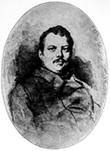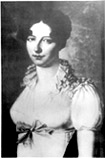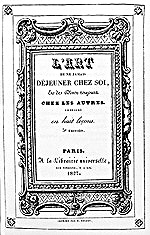I. History of the Deberny Typefoundry
A history of the Deberny et Peignot typefoundry begins with the illustrious inception of the Deberny side, which predates that of Peignot. The Deberny foundry traces its origins to three men, J. L. Duplat (17..-1823), Jean François Laurent (1818-1823), and Joseph Gillé (1748-1789), who came together in the late eighteenth or early nineteenth century to start a typefounding enterprise. This business eventually passed to Laurent by 1827.[1] The preceding year on June 4, 1826, French literary legend, Honoré de Balzac (1799-1850), incorporated with typesetter, André Barbier (b. 1793), in a printing and publishing business on the Rue de Marais-Saint-Germain in Paris. Balzac, then an idealistic young writer, wished to have a printing press at his disposal for the proliferation of his own works. At one time, thirty workers were employed at Imprimerie H. Balzac which was funded with 70,000 Francs in borrowed money from Balzac's mother, as well as from his mistress, Mme. De Berny (figs. 1, 2).[2]
Business started well for Balzac and Barbier who showed no discrimination in the kinds of literature that they printed. Eclectic titles that rolled off their presses included: The Art of Receiving Gifts without Reciprocating, The Art of Tying One's Tie, and The Art of Never Dining at Home (fig. 3). They also printed trade directories for the wig-makers and butchers of Paris, political memoirs, and various poems and plays.[3] By 1827, Balzac bought Laurent's typesetting firm in order to extend his immediate control over all aspects of the printing business.[4]
If Balzac had been a prudent entrepreneur instead of a spendthrift, his venture may have succeeded. Instead, Balzac lavished much of his profits on extravagant clothing that was needed to access the social circles of another patron and mistress, the Duchess d'Abrantès. As a result of his financial neglect, his Imprimerie sank into debt.[5] Keen to its demise, Barbier left the business in 1828. Balzac was left with approximately 100,000 Francs in debts and equipment.
Fortunately, Balzac had aligned himself with a powerful ally. Louise-Antoinette-Laure De Berny (1777-1836), Balzac's first mistress whom he described as, "more than a friend, more than a sister, almost a mother and even more than that a sort of visible divinity," forgave her loan and took over the print shop.[6] As the wife of a high-ranking official in the French royal court and god-child of Queen Marie-Antoinette, Mme. De Berny had financial options at her disposal. She entrusted the business to her 19 year-old son, Alexandre De Berny, (1809-1881).[7] Balzac abandoned his miserable attempt at free-enterprise and went on to profit from his literary talents instead.
Alexandre De Berny worked with Jean-François Laurent until 1840 when he was able to buy out the latter's share.[8] In the midst of their partnership, they expanded their type library with a purchase of the wood-engraved letterstock of Pierre Durouchail. This trend of expansion was to characterize the rest of De Berny's tenure as proprietor. After his takeover, De Berny concatenated the particles of his surname to "Deberny," so as not to sully his commercial name with his father's aristocratic title.[9] Deberny worked a total of fifty years in typefounding and printing until another would assume his post.
In 1877, Deberny associated himself with Charles Tuleu—his illegitimate son, purportedly born of a farmer girl. Tuleu inherited the firm in 1881 upon the death of his father, and ran it solo until 1914.[10] He added many fine typefaces to the company's stock, including that of a series of ancient Latins, many calligraphics and neo-elzeviriennes, and a collection of foreign alphabets.[11] Seeking commercial partnership in 1914, a childless Tuleu proposed the merger of his business with that of his wife's family. His wife happened to be Jeanne Peignot, the sister of Georges Peignot, the head of Peignot et Cie, a rival typefoundry. Jeanne's obstinate refusal in associating with her brother prevented any collaboration between the firms. Tuleu partnered instead with an old school pal, Robert Girard. Sole ownership of the business passed to Girard in 1921 when Tuleu retired. The firm was renamed as "Girard et Cie."[12]
Figures



Page Notes
1 "Deberny et Peignot: La Belle Époque de la Typographie," Caractère (Paris) 12 (December 1975), 33-34.Notes
2 Graham Robb, Balzac: A Life, (New York: W. W. Norton & Company, 1994), 127.
3 Robb, 133.
4 "Deberny et Peignot: La Belle Époque de la Typographie," 33.
5 Robb, 136.
6 Robb, 96.
7 Robb, 138.
8 Ron Eason et al eds., Rookledge's International Handbook of Type Designers: A Biographical Directory(Surrey, UK: Sarema Press Publishers, Ltd., 1991), 126.
9 "Deberny et Peignot: La Belle Époque de la Typographie," 35.
10 "Deberny et Peignot: La Belle Époque de la Typographie," 35.
11 Fonderies Deberny & Peignot, Spécimen Général, vol. 1 (Paris: Fonderies Deberny & Peignot, 1926), not paginated.
12 "Deberny et Peignot: La Belle Époque de la Typographie," 37.